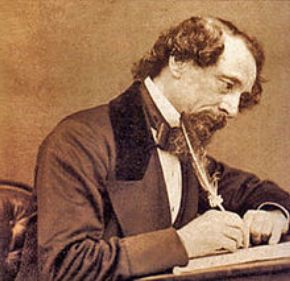Charles Dickens rose to fame through his serialized fiction. Amazon.com is hoping for a 21st century revival with a new program that will present Kindle readers with the works of the favorite authors at $1.99 per digital installment.
From the New York Times...
E-Books Expand Their Potential With Serialized Fiction
By JULIE BOSMAN
Could serialized fiction finally force the e-book to evolve?
Various ventures are trying to satisfy a common complaint about e-books: that they are simply black-and-white digital reproductions of long-form print books, flat and unoriginal in their design and concept. One variation, what publishers call enhanced e-books, with audio and video elements woven throughout the text, has largely fallen flat with readers.
But serialized fiction, where episodes are delivered to readers in scheduled installments much like episodes in a television series, has been the subject of an unusual amount of experimentation in publishing in recent months. In September, Amazon announced Kindle Serials, stories sold for $1.99 and published in short episodes that download onto the Kindle as the episodes are released. Three of the first eight serials were produced by Plympton, a new literary studio.
In August, Byliner, a digital publisher, announced that it would begin a new digital imprint devoted to serialized fiction, with work by Margaret Atwood and Joe McGinniss at its start.
One of the most talked-about new experiments is taking serialized fiction a step further. Set to make its debut on Monday, it is a novel called "The Silent History" that is available on the AppleiPhone and its iPad. It includes interactive, user-generated elements.
The app itself is free, but readers pay for the book's content, which arrives in daily installments of about 15 minutes' worth of reading.
Eli Horowitz, a former publisher of McSweeney's, said the project grew out of his despair over the state of e-books when they began to emerge in earnest several years.
"It was a little bit of a depressing moment," Mr. Horowitz said last week. "We spent a lot of time making these print books into beautiful objects. And it seemed depressing to just squeeze them into a device. The prettiest e-book was still a little uglier than the worst book."
He created "The Silent History" with Russell Quinn, a co-founder of the digital studio Spoiled Milk; Kevin Moffett, the author of "Further Interpretations of Real-Life Events," a story collection; and Matthew Derby, an author and designer.
They wrote a 160,000-word book and, using the iPhone for inspiration, created a "scavenger hunt" element allowing readers to see more story lines by visiting specific locations - like China and Washington, D.C. - that are outlines on a map within the app. Users can also add their own story lines.
The whole idea, Mr. Horowitz said, is finding ways for devices like the iPhone to tell a story in a way that a print book could not.
"It's a way to create a communal reading experience, so people can experience it in a certain time span together," Mr. Horowitz said. "What we tried to make was something that allowed for the reader to approach it in his or her way. We wanted to allow for all levels of interest and obsession."

No comments:
Post a Comment